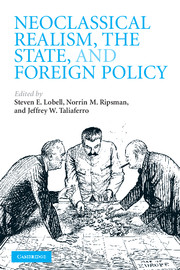Book contents
- Frontmatter
- Contents
- List of figures
- List of tables
- List of contributors
- Acknowledgments
- 1 Introduction: Neoclassical realism, the state, and foreign policy
- 2 Threat assessment, the state, and foreign policy: a neoclassical realist model
- 3 Neoclassical realism and strategic calculations: explaining divergent British, French, and Soviet strategies toward Germany between the world wars (1919–1939)
- 4 Neoclassical realism and identity: peril despite profit across the Taiwan Strait
- 5 Neoclassical realism and the national interest: presidents, domestic politics, and major military interventions
- 6 Neoclassical realism and domestic interest groups
- 7 Neoclassical realism and resource extraction: State building for future war
- 8 Neoclassical realism and state mobilization: expansionist ideology in the age of mass politics
- 9 The limits of neoclassical realism: additive and interactive approaches to explaining foreign policy preferences
- 10 Conclusion: The state of neoclassical realism
- Index
- References
7 - Neoclassical realism and resource extraction: State building for future war
Published online by Cambridge University Press: 05 June 2012
- Frontmatter
- Contents
- List of figures
- List of tables
- List of contributors
- Acknowledgments
- 1 Introduction: Neoclassical realism, the state, and foreign policy
- 2 Threat assessment, the state, and foreign policy: a neoclassical realist model
- 3 Neoclassical realism and strategic calculations: explaining divergent British, French, and Soviet strategies toward Germany between the world wars (1919–1939)
- 4 Neoclassical realism and identity: peril despite profit across the Taiwan Strait
- 5 Neoclassical realism and the national interest: presidents, domestic politics, and major military interventions
- 6 Neoclassical realism and domestic interest groups
- 7 Neoclassical realism and resource extraction: State building for future war
- 8 Neoclassical realism and state mobilization: expansionist ideology in the age of mass politics
- 9 The limits of neoclassical realism: additive and interactive approaches to explaining foreign policy preferences
- 10 Conclusion: The state of neoclassical realism
- Index
- References
Summary
In the mid-nineteenth century, China and Japan faced the rising threat of western imperialism. Yet, despite the two countries' cultural ties and geographic proximity, their responses to that threat were quite different. When confronted with growing anti-Manchu rebellions at home and British demands for trade concessions in the 1830s, the Qing dynasty proved unable to mobilize the resources necessary to defend the empire. The first and second Opium Wars revealed disparities in military technology between China and the European great powers. Faced with internal unrest and the prospect of China's dismemberment, Chinese provincial leaders made an attempt at internal reform, the so-called Tongzi Restoration (1862–74), aimed at reforming the military, creating an arms industry, and strengthening traditional Confucian government. Although these and later reforms prolonged the Qing dynasty until 1911, they were insufficient to halt China's relative decline.
News of China's defeat in the Opium Wars, carried by Dutch and Chinese ships to Nagasaki and then relayed to the shogun at Edo (Tokyo), shocked Japan's feudal elite. The arrival of Commodore Matthew Perry and his “black ships” in Edo Bay in July 1853 ended Japan's two centuries of self-imposed isolation. The Tokugawa shogunate's inability to defend the country led to its overthrow in 1867–8 by a group of samurai from Satsuma and Choshu, who acted to “restore” the sixteen-year-old Emperor Meiji. The new leadership spent the next twenty years methodically emulating the military, political, and technological practices of the European great powers.
- Type
- Chapter
- Information
- Neoclassical Realism, the State, and Foreign Policy , pp. 194 - 226Publisher: Cambridge University PressPrint publication year: 2009
References
- 48
- Cited by



